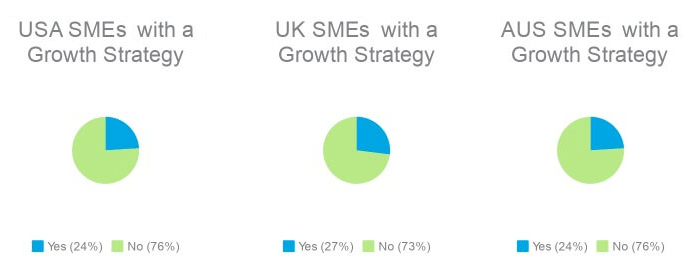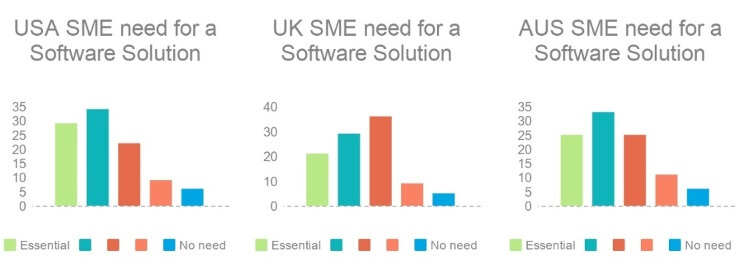How To Be More Successful Than 75% Of SMEs
The SME market is undeniably experiencing solid growth across the USA, the United Kingdom and Australia, resulting in hefty competition and countless challenges.
While the gaps and opportunities for success exist, the question SMEs are asking is how can they become more competitive and more innovative?
Current SME Landscape
What is an SME? Although there are different interpretations and classification for SMEs, it is important to first define the classification of ‘small’ and ‘medium’ as they vary between countries and the domestic economy of those countries.
In this case, definitions of the European Union, the World Bank, the United Nations, the World Trade Organization (WTO) and members of the Organization for Economic Co-operation and Development (OECD) have been used.
The OECD consists of 35 countries: Australia, Austria, Belgium, Canada, Chile, Czech Republic, Denmark, Estonia, Finland, France, Germany, Greece, Hungary, Iceland, Ireland, Israel, Italy, Japan, South Korea, Latvia, Luxembourg, Mexico, Netherlands, New Zealand, Norway, Poland, Portugal, Slovakia, Slovenia, Spain, Sweden, Switzerland, Turkey, United Kingdom, United States – a combined annual GDP of $52 Trillion.
SMEs are broken down further into three categories: micro (1 to 9 employees), small (10 to 49 employees) and medium (50 to 249 employees).
A few countries, notably the USA, categorize medium enterprises as 50 to 500 employees instead of 50 to 250 employees. Revenue, ownership structure, and industry are also taken into consideration.
In OECD countries, SMEs make up approximately 99% of all businesses. SMEs provide the largest share of employment (70%) and provide around 60% of value creation.
Even when ‘informal business’ (common in developing regions) is taken into consideration, SME’s still contribute over 50% of employment globally. In a highly developed country such as Australia, SMEs contribute 57% of the total GDP.
SMEs play a key role in economies globally. They are a critical part of every economy but whether businesses support only local economy or impact international markets, they all have the same challenges in common: how to become more competitive and/or more innovative?
High costs of tax regulatory requirements and substantial compliance costs place small businesses at a disadvantage. Costs are exacerbated by resource and cash flow constraints.
How can such an important and yet vulnerable player in the global economy adapt and grow? Their contributions to economic and social well-being are immeasurable.
In a recent survey of 700 SME CEOs across Australia, the UK, and the USA, 75% of participants reported that they did not have a growth strategy.
A Shifting Tide
SMEs are key players in the economy. The above figures clearly show the importance of SMEs to all countries. How can their potential be maximized?
All SMEs have the potential to increase their participation in the global economy and justifiably reap the rewards that come with success and growth. Business has changed. How can SME’s thrive in a more open environment and be willing participants in the business transformation sweeping across the globe?
The SME market shows no sign of slowing and instead looks set to grow further and become more competitive. Start-up costs might be lower, opportunities greater but the challenges that SMEs face has also grown exponentially.
SMEs are under increased pressure from regulation, finance, innovation, taxation, digitalization, employment, skill shortage, domestic trade, international trade, global value chains, environment and many more.
Not only will emerging technology companies continue to blur the lines of industry categories and place pressure on traditional verticals but the rising value of data and the diminishing value of profit for investors means that these companies not only start quickly and cheaply but they can scale quickly without the burden of making a profit and competitive pricing models.
Many companies are not profitable but the value of their shares remain unaffected by their results.
Some disruptive technology solutions can offer huge gains for SMEs, while others pose significant competitive risks.
The shifting tide indicates that many entrepreneurs no longer see starting a company as a challenge but instead focus on scaling the business as quickly as possible, batten down for the initial storm and use innovation to prosper.
Challenges that SMEs face
In early 2018, Kradle Software commissioned a study of 700 SME CEOs across the US, Australia and the UK. Some repeatable key findings across all three regions are as follows:
-
- Over 86% of businesses surveyed wanted to grow
- Over 67% did not expect significant changes in their business in the next twelve months
- Less than 25% had a growth strategy
- 63% feel that a business management solution is necessary to run their business however on average SMEs only use 1.8 ‘pieces’ of technology, the majority of which are either accounting-only software or tools such as Microsoft Office
- Many business owners still lack the knowledge of technology and fear change
Digital technologies provide a reachable solution to SMEs to improve market intelligence, scale their business without having to make significant investments to achieve growth and access global markets previously out of reach.
New technology allows new companies to be ‘born global’. Despite technology offering so many new opportunities to SMEs to increase their footprint in the global economy, digital transition is seldom implemented.
The adoption lag is due to SMEs consistent inability to invest in assets such as R&D, Human Resources, organization improvements, and process innovation.
The lack of positive action results in a low capacity to convert technological innovation to productivity growth. A large percentage of SMEs find themselves forced into survival mode and unable to plan or even consider a growth strategy.
Businesses enter a spiral of skills shortage, cash flow issues, poor management practices, decreasing profitability or even increasing losses.

Opportunities to Survive and Prosper
Poor management practices, a lack of an appropriate governance structure, low technology deployment and disproportionate financial pressure on SMEs, especially family businesses, have a tangible effect on the growth of SMEs.
Unfortunately, in this new globalized, technology-driven environment, those issues become even more acute.
SMEs must upgrade their management skills, their capacity to gather accurate information on factors affecting their business and invest in technology.
- To be more competitive than 75% of SMEs, businesses need to invest time in a growth strategy.
- Less than half of start-ups survive beyond five years.
- A good growth strategy can only be implemented once a thorough analysis of the market in which the business operates is analyzed and understood. Strengths and weaknesses must be understood and exploited to benefit the business.
- Visibility of the business is paramount. If you cannot measure, you cannot improve.
- Invest time in researching technology that will deliver performance gains and reduce manual and time-consuming tasks.
- Use technology wisely. The learning process never stops. Technology is evolving at a rate never seen before.
- Don’t hand the business over. Business owners work hard to create new opportunities. Take control and use the experience as a launching pad to take the organization to the next level. To achieve growth, innovation must be embraced.

Why We Care
Kradle has experienced the same challenges that SMEs face every day. Unable to find an affordable solution to effectively manage the business, years of experience in designing and building practical and affordable solutions was leveraged and Kradle was launched.
The team at Kradle understands businesses – their frustrations, goals and challenge and the changing tide of market trends.
Kradle offers businesses the opportunity to use software which will help them scale by effectively managing their operations and become more competitive.

